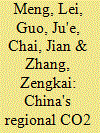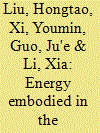|
|
|
Sort Order |
|
|
|
Items / Page
|
|
|
|
|
|
|
| Srl | Item |
| 1 |
ID:
111441


|
|
|
|
|
| Publication |
2012.
|
| Summary/Abstract |
Trades create a mechanism of embodied CO2 emissions transfer among regions, causing distortion on the total emissions. As the world's second largest economy, China has a large scale of trade, which results in the serious problem of embodied CO2 emissions transfer. This paper analyzes the characteristics of China's CO2 emissions embodied in international and interprovincial trade from the provincial perspective. The multi-regional Input-Output Model is used to clarify provincial CO2 emissions from geographical and sectoral dimensions, including 30 provinces and 28 sectors. Two calculating principles (production accounting principle and consumption accounting principle, Munksgaard and Pedersen, 2001) are applied. The results show that for international trade, the eastern area accounts for a large proportion in China's embodied CO2 emissions. The sectors as net exporters and importers of embodied CO2 emissions belong to labor-intensive and energy-intensive industries, respectively. For interprovincial trade, the net transfer of embodied CO2 emissions is from the eastern area to the central area, and energy-intensive industries are the main contributors. With the largest amount of direct CO2 emissions, the eastern area plays an important role in CO2 emissions reduction. The central and western areas need supportive policies to avoid the transfer of industries with high emissions.
|
|
|
|
|
|
|
|
|
|
|
|
|
|
|
|
| 2 |
ID:
109643


|
|
|
|
|
| Publication |
2011.
|
| Summary/Abstract |
This paper analyzes the characteristics of China's regional CO2 emissions and effects of economic growth and energy intensity using panel data from 1997 to 2009. The results show that there are remarkable regional disparities among eastern, central and western areas, regional elasticities of per capita GDP and energy intensity on CO2 emissions, which reflect the regional differences in economic development, economy structure and restraining function of energy intensity decrease on the emission. Energy intensity reducing is more effective to emission abatement for provinces with higher elasticity of energy intensity, but may not be significant for provinces with lower elasticity. The inverse distribution of energy production and consumption, regional unfairness caused by institutional factors like energy price and tax system result in inter-regional CO2 emission transfer embodied in the power transmission. The calculation indicates that the embodied emission transfer was gradually significant after 2003, from eastern area to the central and western areas, especially energy production provinces in central area, which leads to distortion on the emission and emission intensity. The regional emission reduction targets and supporting policies should be customized and consistent with the actual situations rather than setting the same target for all the provinces.
|
|
|
|
|
|
|
|
|
|
|
|
|
|
|
|
| 3 |
ID:
097204


|
|
|
|
|
| Publication |
2010.
|
| Summary/Abstract |
Growing international trade has not only positively affected the People's Republic of China's (China's) economic development, but also expanded the exportation of energy embodied in goods during their production. This energy flow out will pose risks to China's rational utilization of natural resources as well as environmental protection. In this paper, we evaluate the energy embodied in goods produced in China during 1992-2005 and use input-output structural decomposition analysis to identify five key factors causing the changes of energy embodied in exports. (Direct primary energy efficiency, primary energy consumption structure, structure of intermediate inputs, structure of exports, and scale of exports.) For the three sub-periods of 1992-1997, 1997-2002, and 2002-2005, results show that China is a net exporter of energy, and the energy embodied in exports tends to increase over time. The expanding total volume of exports and increasing exports of energy-intensive goods tend to enlarge the energy embodied in exports within all three sub-periods, but these driving forces were offset by a considerable improvement of energy efficiency and changes in primary energy consumption structure from 1992 to 2002 and the effects of structure of intermediate input only in the sub-period from 1992 to 1997. From 2002 to 2005, the sharp augmentation of energy embodied in exports was driven by all the five factors. Our research has practical implications for the Chinese economy. Results of this study suggest that the energy embodied in trade should receive special attentions in energy policies design to limit the energy resource out-flow and pollution generation.
|
|
|
|
|
|
|
|
|
|
|
|
|
|
|
|
|
|
|
|
|